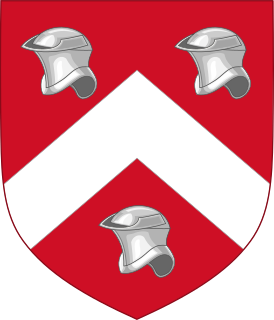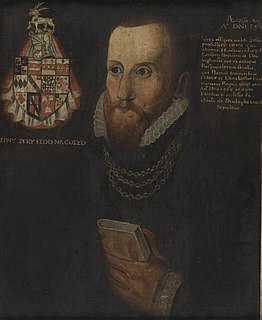
Sir Owen Tudor was a Welsh courtier and the second husband of Catherine of Valois (1401–1437), widow of King Henry V of England. He was the grandfather of Henry VII, founder of the Tudor dynasty.

The Kingdom of Gwynedd was a Welsh kingdom and a Roman Empire successor state that emerged in sub-Roman Britain in the 5th century during the Anglo-Saxon settlement of Britain.
Morgan Llwyd was a Puritan Fifth Monarchist and Welsh language poet and prose author.
Ednyfed Fychan, full name Ednyfed Fychan ap Cynwrig, was a Welsh warrior who became Seneschal to the Kingdom of Gwynedd in Northern Wales, serving Llywelyn the Great and his son Dafydd ap Llywelyn. Fychan claimed descent from Marchudd ap Cynan, Lord of Rhos, 'protector' of Rhodri Mawr, King of Gwynedd. He was the ancestor of Owen Tudor and thereby of the Tudor dynasty.

Humphrey Llwyd (1527–1568) was a Welsh cartographer, author, antiquary and Member of Parliament. He was a leading member of the Renaissance period in Wales along with other such men as Thomas Salisbury and William Morgan. His library, together with those of his patron, the Earl of Arundel and his brother-in-law, Lord Lumley, formed the basis of the Royal Collection of books; currently housed at the British Library. His motto was Hwy pery klod na golyd.
Goronwy Owen was one of the 18th century's most notable Welsh poets. He mastered the 24 traditional bardic metres and, although forced by circumstances to be an exile, played an important role in the literary and antiquarian movement in Wales often described as the Welsh Eighteenth Century Renaissance. A perfectionist who only published reluctantly and whose literary output is consequently relatively small, his work nevertheless had a huge influence on Welsh poetry for several generations and his poetry and tragic life gave him a cult status in Welsh literary circles.
Edmund Salusbury Ffoulkes was a British clergyman who converted from Anglicanism to Catholicism and back again in the 19th century.
Syr Hywel y Fwyall, or 'Hywel of the Battleaxe', was a Welsh knight and hero. He is also referred to as Sir Hywel ap Gruffydd.
Rhys ap Tudur was a Welsh nobleman and a member of the Tudor family of Penmynydd. He held positions of power on behalf of King Richard II of England, including two periods as the Sheriff of Anglesey in the 1370s and 80s. Rhys accompanied the king on a military expedition to Ireland in 1398, but in 1400 began to support the revolt of his cousin Owain Glyndŵr against King Henry IV of England. In 1401, he and his brother Gwilym ap Tudur took Conwy Castle after infiltrating it, and liaised with Henry Percy prior to his own rebellion in 1403. After being outlawed by the king in 1406, Rhys was captured and executed at Chester in 1412, although later oral tradition claims he returned to Anglesey to die there.
Maredudd ap Tudur was a Welsh soldier and nobleman from the Tudor family of Penmynydd. He was one of five sons of Tudur ap Goronwy, and was the father of Owen Tudor. Maredudd supported the Welsh patriot Owain Glyndŵr in 1400, alongside his brothers Rhys ap Tudur and Gwilym ap Tudur; Owain was their cousin.

The Tudors of Penmynydd were a noble and aristocratic family, connected with the village of Penmynydd in Anglesey, North Wales, who were very influential in Welsh politics. From this family arose Owen Tudor and thereby the Welsh Tudor dynasty, that ruled England from 1485 to 1603. The Tudor dynasty came to an end in the 17th century.
Goronwy ap Tudur Hen, also known as Goronwy ap Tudur or Goronwy Fychan, was a Welsh aristocrat and Lord of Penmynydd. He was a member of the Tudor family of Penmynydd, Anglesey, North Wales, and a direct ancestor of Owen Tudor and thereby the Royal House of Tudor. He was a soldier for the English crown, who fought in the First War of Scottish Independence, including in the English invasion which led to the Battle of Bannockburn. He remained loyal to King Edward II of England until the king's death, and was both a yeoman and forester of Snowdon. After his death in 1331, his body was interred in Llanfaes Friary, near Bangor, Gwynedd.
Tudur ap Goronwy was a Welsh landowner, soldier and administrator of the Tudors of Penmynydd family from the island of Anglesey.
Tudur Hen or Tudur ap Goronwy was a Welsh aristocrat and a member of the Tudor family of Penmynydd, Anglesey, North Wales. He was one of three sons of Goronwy ab Ednyfed who received lands from King Edward I of England. Nonetheless, he backed the rebellion of Madog ap Llywelyn, but afterwards swore allegiance to both Edward I and his son, Edward of Caernarfon. Tudur Hen was responsible for the restoration of the Franciscan friary at Bangor, where his body was later placed on 11 October 1311.
Goronwy ab Ednyfed was seneschal to Llywelyn ap Gruffudd, king of Gwynedd. Goronwy was the founder of the Tudor family of Penmynydd.

Pentrefoelas is a village and community in Conwy County Borough, Wales. The village lies on the A5 road between Betws-y-Coed to the west and Cerrigydrudion to the east. The Afon Merddwr river, a tributary of the River Conwy, flows through it. The community had a population of 356 at the time of the 2011 census, 70% were able to speak Welsh. It has an area of 53.86 km2 and covers a large region around the village including part of Mynydd Hiraethog, Llyn Alwen and part of Alwen Reservoir. It is in the electoral ward of Llangernyw. The community includes the small settlement of Rhydlydan.

Nantclwyd Hall is a 17th-century Grade II* listed mansion near the village of Llanelidan, Denbighshire, Wales, built by the Parry family, and rebuilt by Eubule Thelwall and his wife Mary Parry, the heiress of the estate.
Gwilym ap Tudur was a Welsh nobleman and a member of the Tudor family of Penmynydd. In 1401, he and his brother Rhys ap Tudur took Conwy Castle after infiltrating it, in support of their cousin Owain Glyndŵr. Gwilym was subsequently pardoned in 1413, following the execution of his brother a year earlier.
Sir Gruffydd Llywd, or Gruffydd ap Rhyd ap Gruffydd ap Ednyfed was a Welsh nobleman notable for his involvement in quashing Roger Mortimer’s 1322 revolt against King Edward II. Throughout his life until his death in 1335, Llwyd held high-ranking positions in Welsh society, with Lordships in Tregarnedd and Dinorwig and serving as Sheriff of Caernarfonshire, Anglesey and Merionethshire. Son of loyalist Rhys ap Gruffyd, Gruffyd Llwyd was a supporter of King Edward I and King Edward II, helping to enforce conformity to English rule along the Welsh Marches. Historical folklore has often mistakenly portrayed Llwyd as a ‘Welsh Rebel’ who challenged King Edward II, though this has been strongly disputed by historians.







